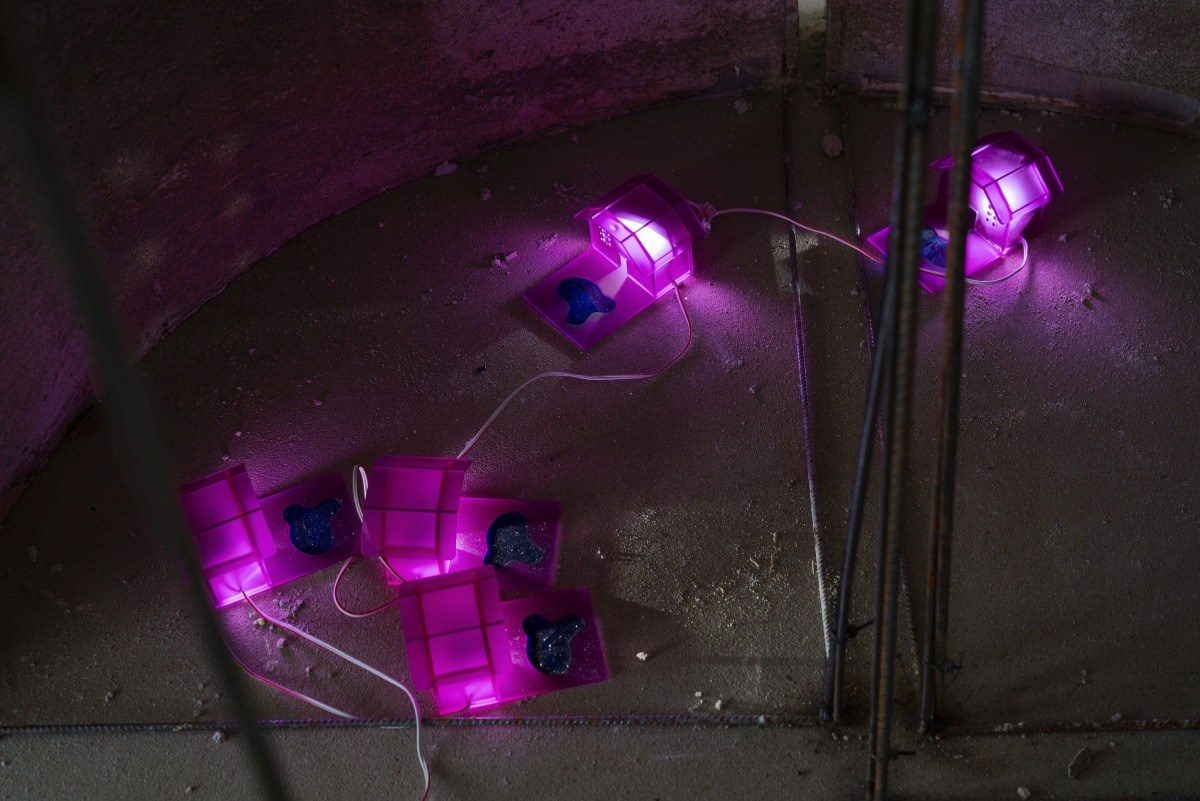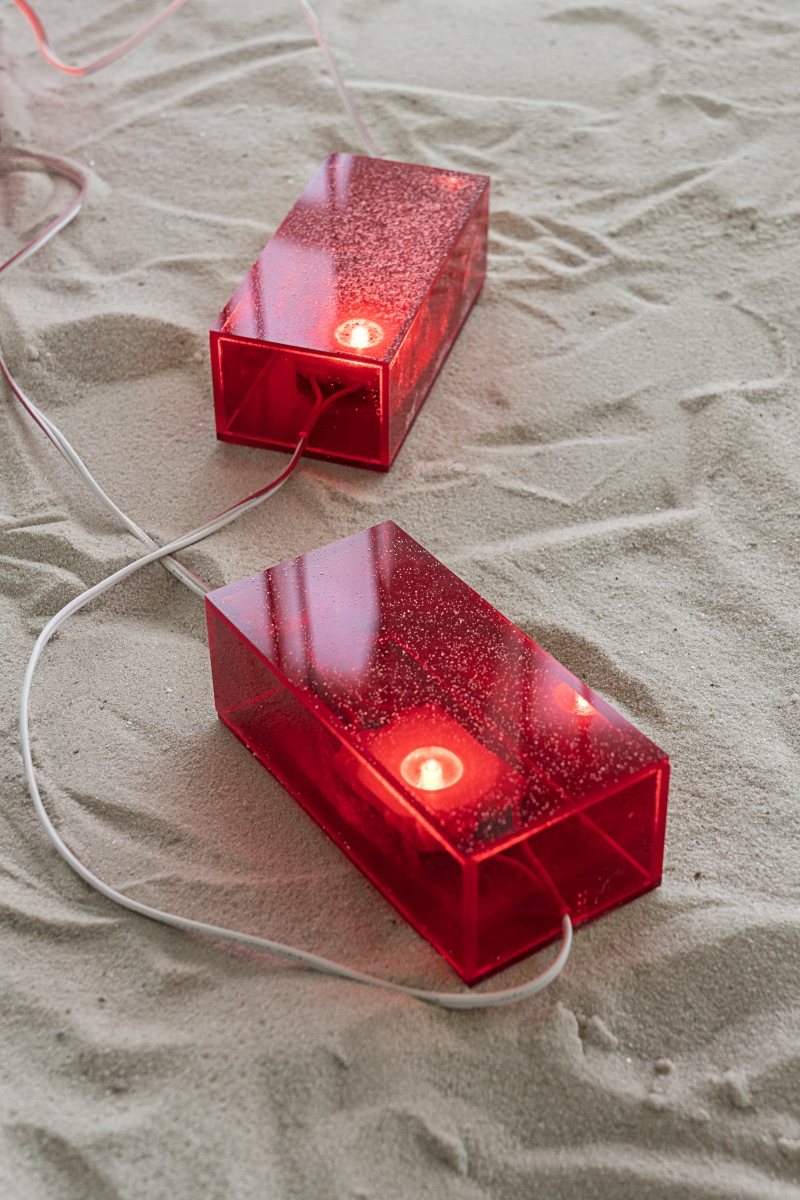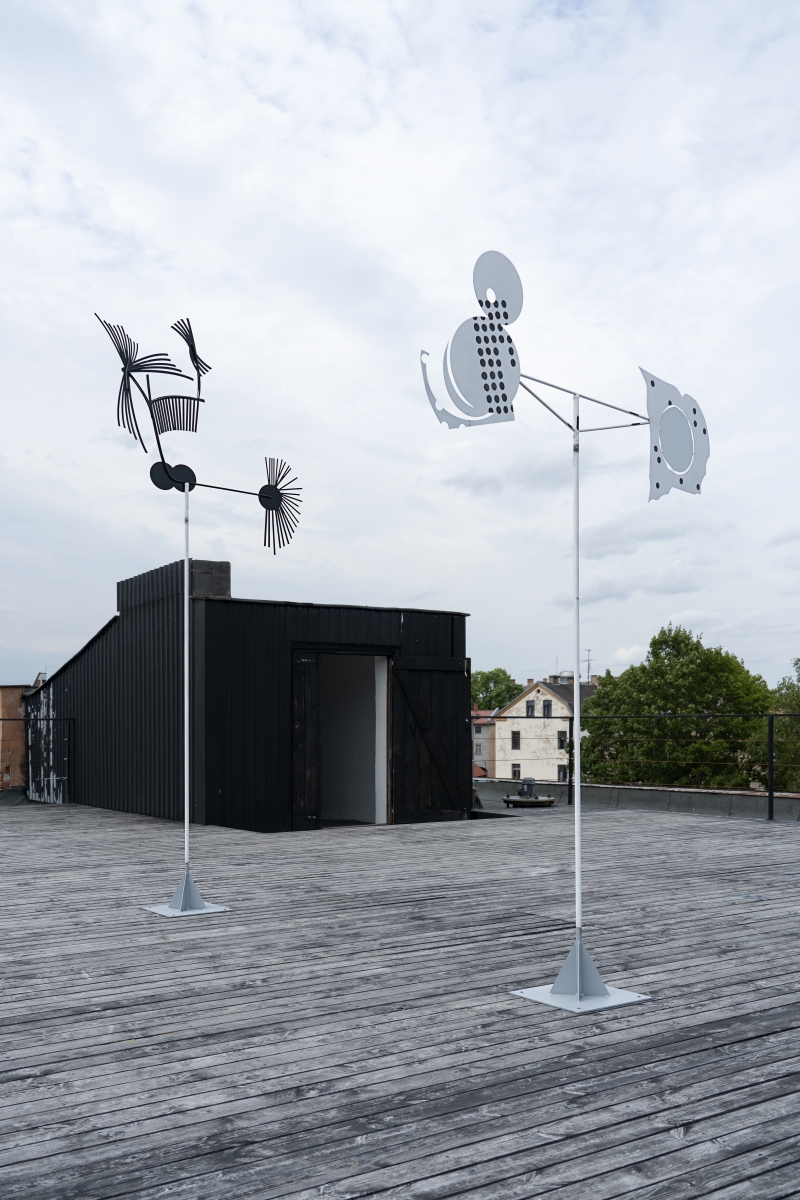‘Blue Lagoon House’ is a joint project by Evita Vasiļjeva and Kaspars Groševs, combining two different yet also kindred art practices where an essential role is played by the relationship between art works and space and its elements. The project refers to the rich and conceptually packed body of work and activities of NSRD (Nebijušu sajūtu restaurācijas darbnīca ‒ Workshop for the Restoration of Unfelt Feelings) and its idea of ‘approximate art’, transferring Hardijs Lediņš’ drawing of a utopian Pārdaugava landscape entitled ‘Blue Lagoon House’ (1984) to Cēsis and encasing the whole building of the art centre in an immersive and multi-layered installation. Merging the ruggedness of the industrial environment and the installation’s vibrations in space, the artists aim to entwine and set into motion the driving forces of the contemporary and recent art processes that are revealed both in the processuality of the exhibition and in its materials and their interplay ‒ audially and visually. Through layers of light and sound frequencies, the show highlights the individual works by Groševs and Vasiļjeva that share various materialities and their confluence, overlapping, collisions and mirroring, with the gestures by the two artists occasionally resonating and merging.
The exhibition features sculptures, installations, large-scale architectural structures, video works and paintings by Groševs and Vasiļjeva that populate the architecture of the space, woven into a nuanced web of references merging personal and collective histories ‒ lost and found contemporaries, transitional states enveloped by the sound of air currents, meeting places of creative communes, light transitions and their reflection in the lines of the works, seven reasons for sunsets and friction between sound waves. The show will see a reopening of the Lagoon booth, a project that initially ran in late summer 2021 in Riga, Vagonu Street, and was a collaboration between nine artists, featuring contributions by other creative figures during the opening events.
Participating artists of the Lagoon project were 0.0.1.0.0., Maija Kurševa, Anna Malicka, Dzelde Mierkalne, Luīze Nežberte, Līva Rutmane, $hady Ladies and Klāvs Upaciers, a mixed group of artists representing different generations and sharing an interest in building creative communities around themselves, frequently realising their activities in ways that are somewhat removed from the public eye. Lagoon was the point of intersection for winds blowing from different directions; the same winds permeate the principal exhibition of the ‘Blue Lagoon House’, namely, Groševs’ paintings and Vasiļjeva’s sculptures, but also fuel the air current catchers by the French artist Kamil Bouzoubaa-Grivel on the roof of the art centre building.
Playing on both the physical and conceptual scale, the exhibition at Cēsis Centre for Contemporary Art will invite on a journey of searching for the ‘sunken ship’ hidden in Lediņš’ drawing, navigating by-layers of the industrial building that are interconnected with light transitions, similar to the built-in requirement of including a night/day transition in the NSRD ‘Walk to Bolderāja’ performances. Sound travels alongside light, occasionally combining with moving pictures, in other cases ‒ resonating with spatial elements and their humming, as well as their extensions in tape loops interwoven with underground rhythms and their broken pieces that melt and dissipate in the bends and openings of the building. The painting series, video work and sound installation by Kaspars Groševs is interspersed with momentary attempts to capture episodes of cultural processes, present and past, dissolved in fragmentary flashes, interrupted words, captured gestures and almost-solved mysteries of lost contemporaries. The interaction between various media also reflects their scale through their relationship and connection with space as the sound inhabits the vast halls, occasionally interplaying with Evita Vasiļjeva’s utopian architectural concrete sculptures, built gradually during the months when the artist lived and worked in Cēsis, using the rooms as a beach of an island, creating her sculptures from bucket-loads of sand, cement and water to the soundtrack of the NSRD records and draught.
In her works, the materials used and the physical process, Vasiļjeva focuses on the transitional state in which the processuality of forms is revealed as existence between emerging, disintegrating or disappearance. Concrete as a material refers to recent past that was known to contain flashes of imagined utopias. Architects of the Bauhaus school imagined an urban environment adapted to utilitarian needs ‒ bringing light to workplaces and living quarters. Factories were transformed into ‘cathedrals of work’. Re-enforced with iron rods, open concrete became the fundamental element of early 20th-century avant-garde architecture and has largely retained its significance to date. Combined with other materials, in Vasiļjeva’s work it obtains its form through their weight and plasticity. The large-scale concrete sculptures will be complemented by cast lamps in which glass is replaced with melted and moulded soap ‒ the series ‘Seven Reasons to Spend Time for Sunsets’, a reflection of the rhythms of time and the hypnotic nature of the sun.
‘Blue Lagoon House’ strives to capture the winds that blow through the city of Cēsis and the currents they bring along ‒ the currents that, through Vasiļjeva and Groševs’ show and contribution by guest artists, capture the imprint of the NSRD legacy in Latvian art, music and creative everyday life. In the light of recent global events, it seems increasingly important to appreciate ‘local’ creative communities that, despite the seemingly endless variety of virtual communication, ensure a much more generous and personal exchange of opinions and art experience. Groševs is the one who attempts to capture the light they emit in a more tangible way in his works, searching for the pulse born out of fleeting moments and its origins in cassette tapes and field recordings, placing them side by side with roughly painted features of remembered faces. As we follow the light, Vasiļjeva’s utopian architectural sculptures are revealed, guiding us through the space and inviting to follow the wind to the top.
-KG
Blue Lagoon House
Evita Vasiļjeva, Kaspars Groševs
Curated by Daiga Rudzāte, Žanete Skarule
Participating: 0.0.01.0.0., Maija Kurševa, Anna Malicka, Dzelde Mierkalne, Luīze Nežberte, Līva Rutmane, Shady Ladies, Klāvs Upaciers, Kamil Bouzoubaa-Grivel
Cēsis Contemporary Art Centre, Cēsis, Latvia
9/07 – 14/08/2022
Photography: Līga Spunde


Installation view

Evita Vasiljeva. Seven Reasons Why You Should Make Time for the Sunsets I-V. 2020-21. Soap, flies from Latvia, plastic, metal, pigments, wires, lamp

Installation view

Poster wall by the unknown authors. 2009-22

Installation view

Kaspars Groševs. Lagoon. 2021-22. Participating artists: 0.0.01.0.0., Maija Kurševa, Anna Malicka, Dzelde Mierkalne, Luīze Nežberte, Līva Rutmane, Shady Ladies, Klāvs Upaciers

Hardijs Lediņš. Blue Lagoon House. 1984. Reproduction. Courtesy of Latvian Museum of Architecture Collection

Installation view

Installation view

Evita Vasiljeva. Seven Reasons Why You Should Make Time for the Sunsets I-V. 2020-21. Soap, flies from Latvia, plastic, metal, pigments, wires, lamp

Installation view

Kaspars Groševs. SWIM #29 (DK). 2022. Oil on canvas

Installation view

Kaspars Groševs. SWIM #10 (AЯ). 2021. Oil on canvas

Kaspars Groševs. SWIM #9 (Into the Sea). 2021. Oil, acrylics on canvas

Installation view

Kaspars Groševs. SWIM #0 (MAD WAN DOGG’S PACIENT ZERO). 2022. Acrylics, spray paint on canvas

Installation view

Kaspars Groševs. Moshpit. 2022. Oil, acrylics, spray paint on canvas

Kaspars Groševs. SWIM #1. 2022. Oil, acrylics, spray paint on canvas

Kaspars Groševs. SWIM #2 (IV). 2022. Oil, acrylics on canvas

Evita Vasiljeva. Seven Reasons Why You Should Make Time for the Sunsets I-V. 2020-21. Soap, flies from Latvia, plastic, metal, pigments, wires, lamp

Installation view

Installation view

Installation view

Upper: Kaspars Groševs. Sunken Ship. 2022. Oil, print on canvas. Lower: Evita Vasiljeva. Heather. 2022. Concrete, metal, paint

Evita Vasiljeva. Bells. 2022. Steel rods, concrete, LEDs

Evita Vasiljeva. Bells. 2022. Steel rods, concrete, LEDs

Evita Vasiljeva. Bells. 2022. Steel rods, concrete, LEDs

Evita Vasiljeva. Bells. 2022. Steel rods, concrete, LEDs

Installation view

Kaspars Groševs. Gathering. 2022. Oil, acrylics on canvas

Installation view

Evita Vasiljeva. Little Soap Opera I-VI. 2022. Soap, fiels, pigments, thread


Evita Vasiljeva. Bells. 2022. Steel rods, concrete, LEDs

Evita Vasiljeva. Little Soap Opera I-VI. 2022. Soap, fiels, pigments, thread

Installation view

Kaspars Groševs. Migratory Birds. 2022. Oil, acrylics on canvas

Kaspars Groševs. Approaching the Blue Lagoon House. 2022. Oil, acrylics on canvas

Evita Vasiljeva. Bells. 2022. Steel rods, concrete, LEDs

Installation view

Installation view

Evita Vasiljeva. Little Soap Opera I-VI. 2022. Soap, fiels, pigments, thread

Kaspars Groševs. Entrance. 2022. Oil, acrylics on canvas

Evita Vasiljeva. Heather. 2022. Concrete, metal, paint

Installation view

Kaspars Groševs. Back and Forth. 2022. Tape loops, 4 channel sound installation

Evita Vasiljeva. Bells. 2022. Steel rods, concrete, LEDs

Evita Vasiljeva. Bells. 2022. Steel rods, concrete, LEDs

Evita Vasiljeva. Bells. 2022. Steel rods, concrete, LEDs

Evita Vasiljeva. Stars. 2022. Plexiglas, light, electricity, ceiling

Kamil Bouzoubaa-Grivel. Reverse Don Quixote. 2022. Painted metal, fabrics

Kamil Bouzoubaa-Grivel. Reverse Don Quixote. 2022. Painted metal, fabrics

Kamil Bouzoubaa-Grivel. Reverse Don Quixote. 2022. Painted metal, fabrics

Kamil Bouzoubaa-Grivel. Reverse Don Quixote. 2022. Painted metal, fabrics

Kamil Bouzoubaa-Grivel. Reverse Don Quixote. 2022. Painted metal, fabrics





























